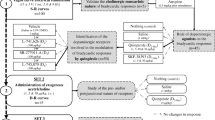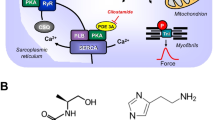Summary
Depolarization and reduction in the C fibre compound action potential (C spike) in response to 5-HT were recorded simultaneously from rabbit isolated vagus nerve. 5-HT (0.1–100 μmol/l) was applied cumulatively and EC50 and IC50 values measured from individual concentration-response curves. Blockade of 5-HT responses by the 3-indazole carboxamide, BRL 43694, was investigated and compared with the blocking action of metoclopramide. BRL 43694 was a selective antagonist of 5-HT responses. A concentration of 10 nmol/l BRL 43694, which nearly abolished the depolarization and reduction of the C spike evoked by 5-HT (100 μmol/l), had no effect on similar responses evoked by DMPP (100 μmol/l) or GABA (100 μmol/l). Blockade of 5-HT responses by BRL 43694 (0.3 nmol/l) was slow in onset, a plateau blockade occurring after equilibrium of tissue with antagonist for 2 to 3 h. Metoclopramide induced a blockade of rapid onset. The maximal blockade was apparent within 30 min of application. Full recovery in the responsiveness of the tissue to 5-HT was observed within 30 min of washing out metoclopramide. BRL 43694 at concentrations of 0.3, 1, 3 and 10 nmol/l caused a progressive rightward shift of the concentration-response curves to 5-HT. At the highest concentration of antagonist, there was some depression of the maximal 5-HT response. The apparent pA2 estimated from the Schild equation was 10.03 ± 0.09 (mean ± SEM, n = 20) against 5-HT depolarization and 10.31 ± 0.1 against C spike reduction. Schild plots had slopes not significantly different from 1.0. The slopes and extrapolated pA2 fitted by linear regression were 0.91 (0.58 – 1.24) and pA2 10.16 (9.74–10.58; mean and 95% confidence levels) for the depolarizations. For reduction in C spikes the slope was 0.74 (0.39–1.08) with a pA2 of 10.86 (10.24–11.49). There was no apparent use-dependent element to the blockade by BRL 43694. Blockade of 5-HT depolarization or C spike reduction by BRL 43694 (0.3 nmol/l) was not significantly different on repeated testing in the presence of the antagonist or without testing of 5-HT until 3 h incubation had elapsed. Metoclopramide at concentrations of 0.3, 1, 3, or 10 μmmol/l progressively shifted concentration-response curves to the right. However, the response maximum, especially that for depolarization, was enhanced in the presence of the antagonist. The apparent pA2 values from the Schilde equation were 7.04 ± 0.04 (n = 20) against 5-HT depolarization and 7.13 ± 0.06 (n = 16) against C spike reduction. Schild plots had slopes significantly less than unity. The lines fitted to the relationship gave pA2 values of 7.41 (7.25–7.57) with a slope of 0.79 (0.69–0.9) against depolarization and 7.63 (7.28–7.97) with a slope of 0.74 (0.54–0.93) against C spike reduction. Metoclopramide at concentrations above 30 μmol/l directly reduced C spike amplitude; the IC50 for the local anaesthetic action was 158 ± 40 μmol/l (mean ± SEM). It is concluded that BRL 43694 is a potent and selective antagonist of 5-HT3 receptors on the rabbit vagus nerve. At concentrations below 10 nmol/l, BRL 43694 appeared to behave as a competitive antagonist while at 10 nmol/l the antagonism was unsurmountable, suggesting a “pseudo-irreversible” antagonism due to slow dissociation of antagonist from the receptor. Although metoclopramide behaved as a surmountable antagonist, the low slope of the Schild plots and the increase in maximal response amplitude in the presence of the antagonist are unexplained features of its blocking action.
Similar content being viewed by others
References
Arunlakshana O, Schild OH (1959) Some quantitative uses of drug antagonists. Br J Pharmacol 14:48–58
Azami J, Fozard JR, Round AA, Wallis DI (1985) The depolarizing action of 5-hydroxytryptamine on rabbit vagal primary afferent and sympathetic neurones and its selective blockade by MDL 72222. Naunyn-Schmiedeberg's Arch Pharmacol 328:423–429
Burridge J, Butler A, Kilpatrick GJ (1989) 5-HT3 receptors mediate depolarization of the guinea-pig isolated vagus nerve. Br J Pharmacol 96:269P
Butler A, Mill JM, Ireland SJ, Jordan CC, Tyers MB (1988) Pharmacological properties of FR 38032 F, a novel antagonist 5-HT3 receptors. Br J Pharmacol 94:397–412
Christian EP, Taylor GE, Weinreich D (1989) Two distinct excitatory effects of serotonin on rabbit visceral C-fibre neurons. J Appl Physiol 67:584–591
Craig DA, Ornstein AG, Clarke DE (1990) An analysis of unsurmountable antagonism to 5-HT in the isolated perfused rat kidney: evidence for pseudoirreversible inhibition. In: Saxena PR, Wallis DI, Wouters W, Bevan P (eds) Cardiovascular pharmacology of 5-hydroxytryptamine. Kluwer, Dordrecht, pp 143–155
Elliott P, Wallis DI (1988) The depolarizing action of 5-hydroxytryptamine on rabbit isolated preganglionic cervical sympathetic nerves. Naunyn-Schmiedeberg's Arch Pharmacol 338:608–615
Elliott P, Wallis DI (1990) Analysis of the actions of 5-hydroxytryptamine on the rabbit isolated vagus nerve. Naunyn-Schmiedeberg's Arch Pharmacol 341:494–502
Elliott P, Seemungal BM, Wallis DI (1989) Antagonism by metoclopramide and BRL 43694 of 5-HT-induced responses in rabbit isolated vagus nerve. Br J Pharmacol 98:663 P
Fake CS, King FD, Sayer GJ (1987) BRL 43694: a potent and novel 5-HT3 receptor antagonist. Br J Pharmacol 91:335P
Fozard JR (1984) Neuronal 5-HT receptors in the periphery. Neuropharmacology 23:1473–1486
Grossman CJ, Bunce KT, Humphrey PPA (1989) Investigation of the 5-HT receptors in guinea-pig descending colon. Br J Pharmacol 97:451P
Ireland SJ, Tyers MB (1987) Pharmacological characterization of 5-hydroxytryptamine-induced depolarization of the rat isolated vagus nerve. Br J Pharmacol 90:229–238
Ireland SJ, Straughan DW, Tyers MB (1987) Influence of 5-hydroxytryptamine uptake on the apparent 5-hydroxytryptamine antagonist potency of metoclopramide in the rat isolated superior cervical ganglion. Br J Pharmacol 90:151–160
Kenakin TP (1980) On the importance of agonist concentration-gradients within isolated tissues. Increased maximal responses of rat vasa deferentia to (−)noradrenaline after blockade of neuronal uptake. J Pharmacol 32:833–838
Kilpatrick GJ, Jones BJ, Tyers MB (1987) Identification and distribution of 5-HT3 receptors in rat brain using radioligand binding. Nature 330:746–748
Lattimer N, Rhodes KF, Saville VL (1989) Possible differences in 5-HT3-like receptors in rat and the guinea-pig. Br J Pharmacol 96:270P
Moss HE, Sanger GJ (1987) Antagonism by BRL 43694 of the pseudoaffective reflex induced by duodenal distension. Br J Pharmacol 92: 531P
Neijt HC, Te Dints IJ, Vijverberg HPM (1988) Pharmacological characterisation of serotonin 5-HT3 receptor-mediated electrical response in cultured mouse neuroblastoma cells. Neuropharmacology 27:301–307
Richardson BP, Engel G, Donatsch P, Stadler PA (1985) Identification of serotonin M-receptor subtypes and their specific blockade by a new class of drugs. Nature 316:126–131
Round A, Wallis DI (1987) Further studies on the blockade of 5-HT depolarizations of rabbit vagal afferent and sympathetic ganglion cells by MDL 72222 and other antagonists. Neuropharmacology 26:39–48
Author information
Authors and Affiliations
Additional information
Send offprint requests to D. I. Wallis at the above address
Rights and permissions
About this article
Cite this article
Elliott, P., Seemungal, B.M. & Wallis, D.I. Antagonism of the effects of 5-hydroxytryptamine on the rabbit isolated vagus nerve by BRL 43694 and metoclopramide. Naunyn-Schmiedeberg's Arch Pharmacol 341, 503–509 (1990). https://doi.org/10.1007/BF00171729
Received:
Accepted:
Issue Date:
DOI: https://doi.org/10.1007/BF00171729




